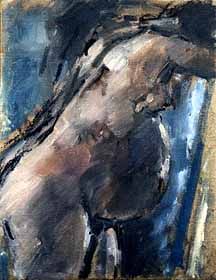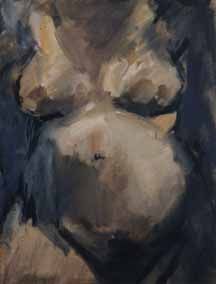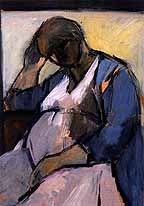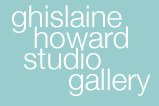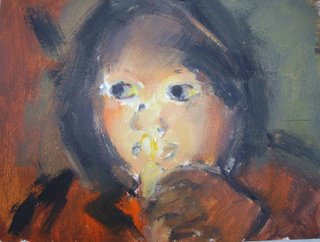MY
FIRST SON Maxim was born on August 28th,
1984 and so, being a painter whose work springs from my own experience,
my pregnancy presented a challenge that I could not ignore without
denying
the central basis of my inspiration. This challenge was the pictorial
representation
of the pregnant figure - a record of my own pregnancy and subsequent
motherhood.
In
the early months of my pregnancy I worked on a series of
paintings based on drawings made in Manchester City Art Gallery. There
I found a particularly fascinating display case containing some
exquisitely balanced Chinese horses which, although small in scale,
gave an impression of weight and massiveness. Despite their obvious
stillness each one was charged with suggested As time passed I became more conscious of my condition and the need to use it as subject matter for my work became more persistent - the question was how to go about it. Other artists had depicted the pregnant figure but it surprises me how rarely the image has appeared in Western art. Those that spring to mind include the Jan van Eyck Arnolfini portrait in the National Gallery (if she is in fact pregnant), the paintings of Paula Modersohn-Becker, and the Madonna del Parto by Piero della Francesca. I visited Italy with my husband when I was still only four months pregnant and fulfilled a long-held ambition to see this particular painting at the little commune of Monterchi, midway between Piero's home town of Arezzo and Borgo Sansepulchro, host to many of the painter's works including the magisterial Resurrection. Several hundred yards away, adjoining the town's cemetery, is the tiny, whitewashed chapel containing the fresco which fills the cool interior with a serene calm. The blueness of the Madonna's dress dominates the composition. Two angels raise the opening of a cylindrical tent, revealing the standing figure of the Virgin. She supports her back with one hand whilst the other reveals her pregnancy by parting her dress at the front to show the white smock beneath. She lacks any sense of coyness or embarrassment, but looks out at the beholder with a fierce and melancholy pride. Although gaining a good deal of support from such images, I realised that the strength of my own work must arise from my own experience. I worked directly from my own image, making a series of large drawings, and with each one I became aware of a new sense of urgency, perhaps due to the lack of time, but more, I feel, because of the direct confrontation that self-portraiture involves. I used a coarse-grained watercolour paper which I worked on with various thicknesses of charcoal, ranging from favouring sticks of medium thickness to the heavy scene-painters' variety. |
| As my pregnancy developed I found standing poses increasingly uncomfortable and so, partly for practical reasons, I decided to work from a seated position. Study for self-portrait, July 1984, is among the first of these. The figure dominates the composition, facing the viewer directly. The pose, which in the earlier drawing is upright and alert with both hands on the knees, has sunk into a relaxed and weary attitude. One hand supports the head and the gaze, whilst being directed outwards, fails to engage completely with the viewer, suggesting a preoccupation with the self. | 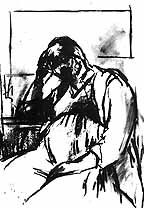
Seated self-portrait with hands
on knees
|
| After
the more intensely worked drawings, I felt
that I was now moving in the direction I wanted. The lines were
stronger,
more expressive of the form and, most of all, contained a real sense of
heaviness, weight and fullness. On an emotional level I was beginning
to
catch the sense of repose and expectancy - that kind of passive
expectancy
felt by the all-night traveller, alone in the small hours, waiting in
some
deserted station.
The drawing had sufficient formal strength to withstand development into a large oil painting and during this process many more changes took place; each refinement kept the work alive. While some artists prefer to work out all their formal problems in preparatory drawings which they then transfer onto a squared-up canvas, I am temperamentally unsuited to such procedures. Although my method is less certain in terms of destination, I prefer to know only the direction in which I am travelling. This allows the journey to be charted each step of the way, keeping my sense of exitement alive at all stages. |
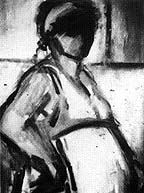
Standing pregnant figure in pink
|
When studies and drawings are complete I pin them on the studio walls around me. I go on to make small oil sketches, often on panels which can withstand and preserve the developments that occur as I continue to draw into the painting with charcoal. The grains of charcoal mix with the paint, adding to the textural and tonal effect. In this way the drawn line creates a dynamic dialogue with the painted areas. These wooden panels have the resilience necessary for the rough treatment they receive. The paint is applied with rapid brushwork using large hogs hair brushes, continually re-defining forms until the painting is resolved. |
Colour,
too, is of great importance. My
use of colour is intuitive and although initially it is based on
observed
reality, as the work progresses certain tones and colours are
heightened
or reduced in a continual balancing act. The elements of line and
colour
battle or harmonise together, aiding the expression of the subject
matter
and welding the picture into a strong cohesive unit in which the hands
and face become the expressive mainspring.
The studies took the image through several successive stages of simplification and during this process the figure became larger within the confines of the picture area and the background detail of the studio was replaced by flat areas of colour. The table that the arm rests on and the structural lines of the easel became heavy bands of dark colour at the top and the left hand side. This closing of the picture space around the figure gave the sense of massiveness and isolation that I sought in the initial sketches. I arrived at an image that for me satisfatorily described the experience of my pregnancy. It was only later, in conversation with my husband, that I recognised an affinity between my painting and Durer's wonderful image of Melancholia. Study for self-portrait
Just when I felt my work was going well life rudely interrupted art when my son Maxim was born almost a month earlier than expected and the large oil painting that I had only just begun remained unfinished. And so it is today. The continuous development of my baby kept presenting me with new subject matter demanding to be recorded. Perhaps when the speed of these changes slows down I will return to finish it, or possibly its very incompleteness represents the experience of the birth of my first child. Next: Ghislaine Howard concludes with a discussion of her work subsequent to the birth of her son. |
Ghislaine Howard Studio Gallery
A Shared Experience Landscape Parent and child Pregnancy Self-portraiture The Empty Tomb The geriatric unit The intimate and the domestic The maternity unit The prison The St Anthony Cycle The Stations of the Cross The theatre The Visitation Wardrobe Working methods |
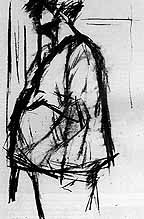
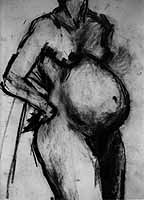
 movement. I did many drawings, altering the scale and emphasis of the
objects and exploiting the inherent ambiguities caused by the
reflections of the glass-sided case. While working on these pictures my
work became larger and more expressive; I was not so much recording the
image before me, but rather recreating it in freer forms with fuller
and looser brushwork. The colours also became less faithful to reality
and more suggestive of mood and atmosphere.
movement. I did many drawings, altering the scale and emphasis of the
objects and exploiting the inherent ambiguities caused by the
reflections of the glass-sided case. While working on these pictures my
work became larger and more expressive; I was not so much recording the
image before me, but rather recreating it in freer forms with fuller
and looser brushwork. The colours also became less faithful to reality
and more suggestive of mood and atmosphere. 